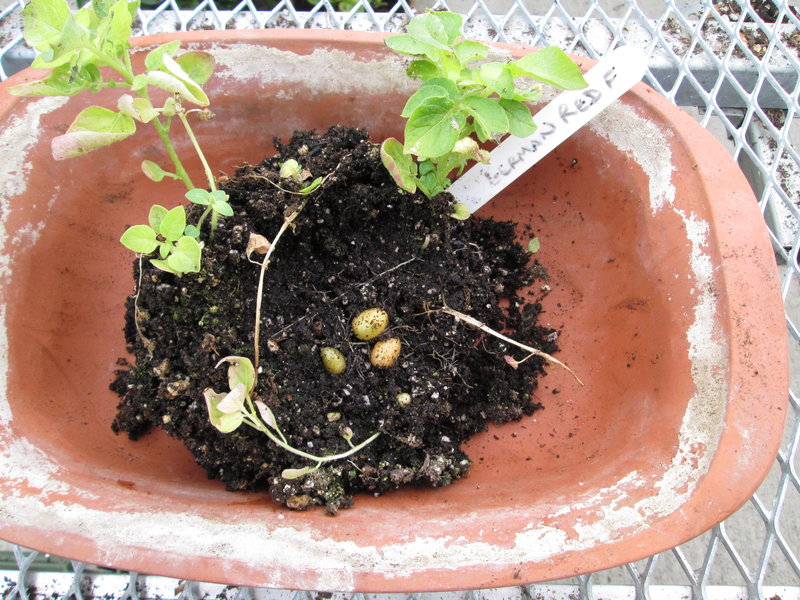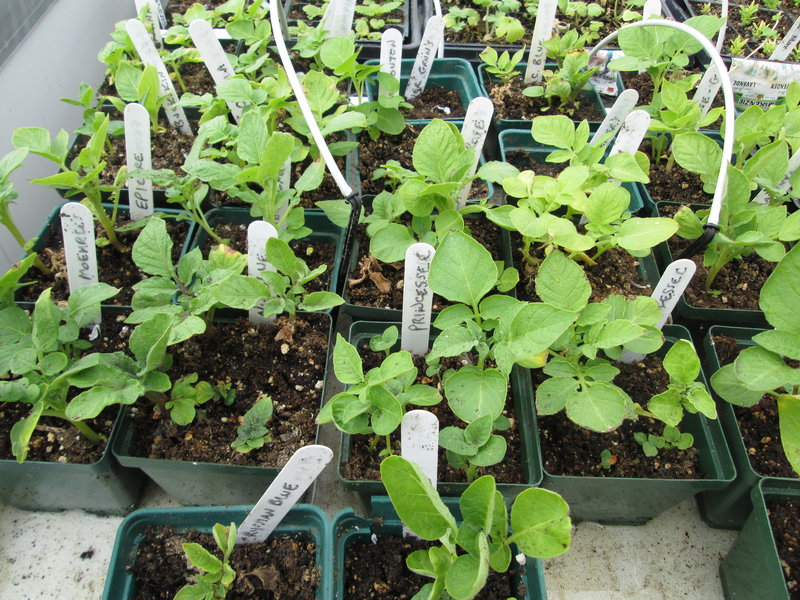How to Keep a Potato Collection Without Any Digging

Bob Wildfong
There are hundreds of really interesting heritage potato varieties worth growing, but most of them are difficult to find. When you find one that you like, it often makes sense to grow it year-by-year because you might not be able to find it again. The problem is, once you have a good collection of varieties, you have to plant them all every spring, and dig them all every summer. Potatoes aren't like seeds that can be put on a shelf for a few years - you can't take a break - they have to be grown continuously.
Here's a method that makes it much easier. You can keep a collection of dozens of potato varieties in a small space, with no digging, no potato beetles, and hardly any effort.
A few years ago I took on a large part of Garrett Pittenger's potato collection. He's been growing and collecting varieties for years, and it was time to spread the effort. I added a few more from other members, and soon I found myself growing 30 varieties! I don't really need 30 rows of potatoes, and I really don't want to dig that much. I'd like to grow quantities of, say, five or six varieties, but the rest I just want to maintain as easily as possible - just enough to be able to grow them out in future years.
After one exhausting season of digging 30 kinds of potatoes, labelling, bagging, storing, and sorting them, I was highly motivated to find an easier way. I found this article on growing potatoes from cuttings:
http://www.fao.org/potato-2008/en/potato/seedtubers.html
FAO is promoting a promising, low-cost alternative: the use of very small cuttings, i.e. a single-node, leaf-bud or other type of plant cutting of about 1.5 cm, which can be grown to produce plantlets on a commercial scale.
 It turns out that potatoes can be grown very easily from cuttings, and grown like small houseplants. Any part of the plant will root, but the best results come from the sprouts that grow from the eyes of the tuber. A little cutting will grow into a tiny potato plant, and in about 4 weeks, it will start to grow tiny tubers. These miniature potato plants are genetically complete, and can be allowed to grow up into full-size crop plants, but for the overwhelmed collector, they are the perfect size for keeping varieties alive (though not producing edible-sized potatoes).
It turns out that potatoes can be grown very easily from cuttings, and grown like small houseplants. Any part of the plant will root, but the best results come from the sprouts that grow from the eyes of the tuber. A little cutting will grow into a tiny potato plant, and in about 4 weeks, it will start to grow tiny tubers. These miniature potato plants are genetically complete, and can be allowed to grow up into full-size crop plants, but for the overwhelmed collector, they are the perfect size for keeping varieties alive (though not producing edible-sized potatoes).
This year I have five varieties in the ground, and they will produce enough potatoes for the winter, but I also have all 30 varieties in miniature form indoors in four-inch pots. Every few months, they naturally turn yellow and "senesce", or die back. Just as in the garden or field, that means they've completed one life cycle, and they have grown miniature tubers. I sift out the mini-tubers, allow them to rest in a cool location for a month, then plant them in pots again.
In all, I am keeping a healthy collection of 30 potato varieties at a cost of a few hours of easy work every three or four months, and about eight square feet of well-lit indoor space. No digging, no potato beetles, and I can bulk up any of those varieties for outdoor planting whenever I want.
--
Bob Wildfong is the Executive Director of Seeds of Diversity, and the Horticultural Specialist at the Waterloo Region Museum. Many thanks to the Waterloo Region Museum for providing modest space for in vivo potato conservation.
Not yet a member?
An annual membership to Seeds of Diversity gives you access to our seed exchange, seed grow-out programs, and our online news.

We depend on donations to do our work.

Thank you for your support!
